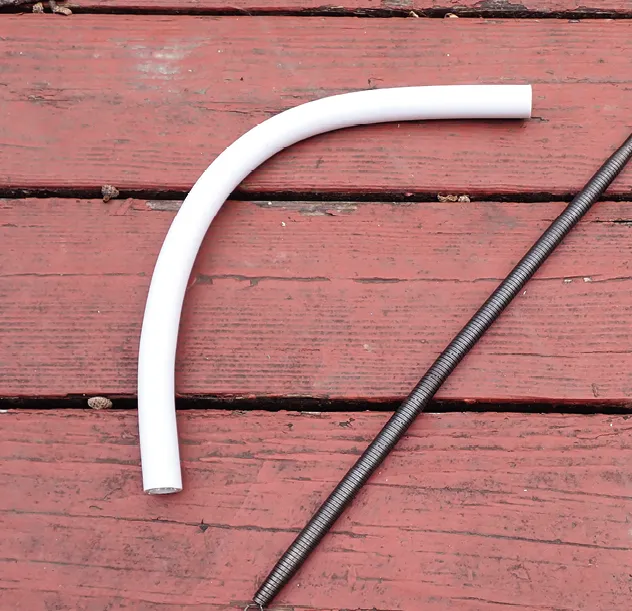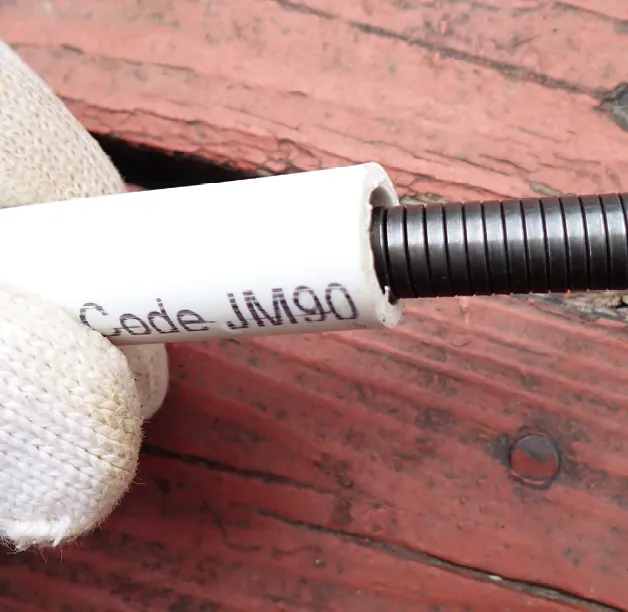Over the decades, marine equipment has gone through a dramatic transformation as plastics have steadily crept into our onboard lives. In this first in a series of articles examining the use plastics on our boat—good and bad—we’ll look at a product that is ubiquitous in home construction, but still less common on boats—rigid PVC (polyvinyl chloride pipe).
There are many varieties of PVC, each with their own properties. For this report on bending PVC tubing, we are focusing on PVC conduit and Schedule 40 PVC. This is the most common variety used on boats (with important caveats; see below), and the type we’ve worked with most. Chlorinated polyvinyl chloride (CPVC), rated by the Food and Drug Administration as “food grade,” is often used for potable systems and for hot water. Heat should bend CPVC, but since building codes prohibit this we have not tested it. Don’t heat bend ABS plastic, nylon, and polyethylene pipe; they will suddenly become too soft to work with.
PVC pipe is something of a miracle product for household plumbing. It is non-leaching, durable, and inexpensive. Fittings are readily available in every hardware store. For sanitary lines it
is impermeable and stink-free, as well as clog resistant. It makes an excellent conduit for wiring projects. The downside is that the pipe is rigid, and it can crack. For this reason, the American Boating and Yacht Council will not permit it for use in any below the waterline plumbing that is connected to an external through hull. For sink drains, cockpit drains, bilge pumps, cooling intakes, or sanitation systems, use only hoses designated for the respective purpose.
Leading PVC through all the twists and turns of a hull can be challenging. Elbow fittings work for sharp turns, but what about more gentle bends? When rewiring, for example, you can’t pull wire around a sharp 90-degree bend. You must install either a preformed curve or use a pulling elbow—an elbow that has an accessible opening for pulling the wire in stages. If the pulling hole is inaccessible, feeding future wires will be a problem.
SHAPING CURVES BY HAND
The easiest way to bend PVC is by applying heat, but using heat for a sharp curve will create a kink. For sharp bends, use an elbow fitting. Short gradual bends in heated PVC can be formed by hand, and it probably won’t kink. If you take the extra step and fill the pipe with hot sand or water, or use a bending spring, you will better prevent kinking (see below).
Bottom line: We frequently bend pipe and conduit by hand while wearing oven mitts or welding gloves. Depending on the project, we may also use a bending spring, or for more complex shapes or longer gradual curves, a bending jig.
BENDING SPRINGS
A bending spring is simply a spring that nearly matches the inside diameter of the pipe you are bending. Because the spring is sold in metric sizes and pipe is often measured in inches, it helps to know which size spring to use. For easy insertion and removal, the spring should be 1-2 millimeters smaller in diameter than the inside of the pipe. Technically, you can use a tighter fitting spring and it will create less distortion, but you may have more trouble removing the spring. Here are the corresponding size springs for common size PVC pipes (inside diameter):
• ½-inch pipe; 13-14 mm spring
• ¾-inch pipe; 18 mm spring
• 1-inch pipe; 23-24 mm spring
• 1½-inch pipe; 36-38 mm spring
Suspended inside the pipe at the desired location, a bending spring helps the pipe to bend without kinking. There is an eye in each end of the spring to attach parachute cord or insulated wire (our preference) for positioning the spring inside the pipe.
Whatever method you use to heat the pipe for bending, the spring should be in place before heating. Bending springs are made from square spring wire so they won’t dent the inside of the pipe and are easy to remove. The springs are about 16-20 inches long, and several can be chained together for long bends. Spring sizes, up to 1-inch, cost about $15-20; a bending spring for 1½-inch pipe costs about $50.
Bottom line: A bending spring is our preferred method for shaping heated PVC pipe to fit short radius bends. If working with a long pipe is too awkward, you can bend the pipe in sections and join the sections using a pipe coupling.
FORMS AND BENDING JIGS
When bending a gently heated piece of pipe using a bending spring, you don’t need a jig. However, when bending larger pipe, making long bends, or if you need a very accurate shape, use a jig. The simplest way to make a jig is to take a plywood sheet, trace the shape you have in mind, drill
1⁄4- to 3⁄8-inch holes along the shape, and insert corresponding diameter dowels into the holes.
Spacing between dowels is about 2-5 times the pipe diameter, depending on the radius of the curve. The dowels can be on the inside of the curve only, but an outside row will help hold the shape while it cools. If you heat the pipe sufficiently and allow more time to cool, the pipe will hold the desired shape. You can accelerate cooling by wiping the warm pipe with a wet cloth or spraying the pipe with water.
Bottom line: A jig with a bending spring is preferred for complex bends, sharp bends, or bends in larger pipe.
HEATING
PVC is an amorphous polymer that softens over a wide range of temperatures, from about 212°F to 275°F. If you overheat it, the pipe gets floppy and kinks. Not enough heat and the pipe may crack or be weakened by the bending process. Once cooled, the pipe will be as stiff and strong as it was originally. The service temperature limit of PVC is 140°F.
Do not heat with a direct flame. You can’t control the temperature and burning plastic can release toxic fumes. A poor conductor of heat, PVC takes time to heat for shaping and time to cool down and regain its stiffness. You can accelerate the cooling by wiping with a damp cloth or spraying with water. Expect to wait 10-30 minutes for the pipe to cool, depending on the size and heating method.
If you will be bending an area of pipe near where you will add a fitting later, loosely slip on a CPVC cap. The higher softening point of the CPVC fitting will prevent the pipe from becoming egg shaped. To prevent the cap from overheating and getting stuck in place, wrap it in a damp rag.

FILL WITH HOT SAND
One simple method for heating PVC involves filling it with hot sand. Stand the pipe on its end and close the lower end of the pipe with duct tape (two crisscrossing pieces is enough). Tape is preferable to caps because it won’t get stuck.
Measure enough playground sand to fill your pipe, and then add an additional cup to compensate for any spillage. Heat the sand to 450°F in an oven. (You an also cook it on a stovetop or grill.) Use a stainless-steel pan. Stir and monitor the temperature with an infrared thermometer. Pour the hot sand into the pipe with a funnel. Close pipe top with duct tape. Although 450°F is above the recommended bending temperature, the conductivity of sand is low and it will not cause the plastic to overheat.
Wait about 2 minutes for the outside of the pipe to reach 200°F and for the pipe to get a little floppy. Bend to a radius of not less than 5 pipe diameters. Cool by running water over the pipe, wiping with a wet cloth, or leaving in a bending jig for 30 minutes or more. Pour out the sand for reuse. Because the sand is incompressible and the ends are sealed, kinking is not a serious problem.
Bottom line: This is the best and easiest method for heating larger diameter pipes, long pipes, and for making gradual turns. It has a longer working time than air heating methods.

BOILING WATER
Filling the pipe in boiling water will soften it enough to make minor bends, but the pipe will crack if you overheat it. Like sand, water can’t compress, so kinking is a not a big problem. However, sand is preferable because it holds shape better.
Bottom line: Using hot water to bend PVC is tricky and is not our favorite method.
HEAT GUN
A heat gun is less helpful than you would think. Because only the outside of the pipe is heated, the pipe remains relatively stiff, so there will be residual stress. However, if you are willing to work slowly, taking five minutes or so to heat the pipe, it is a good method for bending smaller pipes in the field, or for making minor adjustments in alignment.
Bottom line: A heat gun won’t work for creating long gradual turns. It is recommended only for small pipes, short bends, and small projects.
WARMING IN AN OVEN
This process is as simple as it sounds. Place both the pipe and spring in a warm oven set for 220°F-240°F.
Bottom line: This is our favorite method if the part is small enough. Use a bending spring to shape the curve.
CONCLUSION
If you are rewiring or plumbing your boat’s sanitation system and are daunted by the number of curves involved, don’t sweat. Bending PVC is easy and quick. Pipe is cheap, so you can buy enough to practice first. Getting the right curve is simpler than it seems. Buy some bending springs, take your time with the heating, twist the pipe into shape, and cool with a damp cloth. It’s that simple.

































